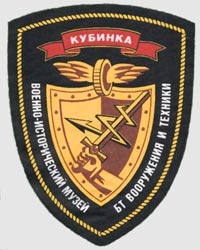This article needs additional citations for verification. Please help improve this articlebyadding citations to reliable sources. Unsourced material may be challenged and removed.
Find sources: "Kubinka Tank Museum" – news · newspapers · books · scholar · JSTOR (May 2019) (Learn how and when to remove this message) |
The Kubinka Tank Museum (Центральный музей бронетанкового вооружения и техники - Tsentral'nyy Muzey Bronetankovogo Vooruzheniya I Tekhniki -Central Museum of Armored Arms and Technology) is a large military museum in Kubinka, Odintsovsky District, Moscow Oblast, Russia where tanks, armoured fighting vehicles (AFVs) and their relevant information are displayed and showcased. The museum consists of open-air and indoor permanent exhibitions of many famous tanks and armored vehicles from throughout the 20th and 21st centuries (between 1917 and the present day). It also houses and displays many unique, unusual and one-of-a-kind military vehicles of which there are very few remaining examples, such as the German Panzer VIII Maus super-heavy tank, Troyanov's Object 279 Kotin heavy tank, the Karl-Gerät heavy self-propelled artillery, and the Object 120 Su-152 "Taran" tank destroyer, amongst other single or limited-production prototypes from the Soviet Union and Nazi Germany.
Военно-Исторический музей Бронетанкового Вооружения и Техники
| |
 | |

Entrance
| |
|
Location within Moscow Oblast | |
| Established | 1972 (1972) |
|---|---|
| Location | Kubinka, Moscow oblast, Russia |
| Coordinates | 55°33′54″N 36°42′56″E / 55.56500°N 36.71556°E / 55.56500; 36.71556 |
| Key holdings | Panzerkampfwagen VIII Maus, Karl-Gerät, Object 279 |
| Visitors | 70,000 a year |

The Kubinka Tank Museum is located on a historically "classified" Red Army armor testing facility. Most of its displays in the museum were derived from the research collection of the still-functioning[citation needed] Kubinka armour testing and proving ground. Most Cold War-era Western tanks (from the US or Western Europe) were war trophies from the Middle East, Africa, Vietnam and Latin America, which were all sent to the armour testing facility at Kubinka to study and focus on any strengths and weaknesses. Due to its secretive history as well as its close relationship with the military, the museum is still staffed entirely by Russian Army personnel today. As belonging to an official military unit, the staff of the museum wears a special sleeve insignia on their uniform.[1]
Since 2014, the museum has been a part of the Patriot military theme park.[2]
As of 2017, access into museum is available for all visitors. The entrance fee is 300–500 rubles (US$4–US$7), depending on the particular part of the site, which is wide-spread. Guided tours in English are more expensive, starting at 4500 (US$60) rubles for each site. Access for children under the age of six is free. Permission to film and record videos of any vehicles thereof is included in the entrance fee. Foreign citizens are recommended to have a copy of their passport to enter the museum, as well as the original version. As it is still part of a Kubinka military base, weapons and alcohol are strictly prohibited; at the entrances, inspections are carried out by security staff with the help of metal detectors.[3]
The museum hosts a wide variety of tanks and armored vehicles developed and used throughout the 20th century by the Soviets, Germans and other nations. Around 60% of the exhibits are Soviet-era vehicles, with the most recent display being the Object 172, the prototype of the T-72 MBT.
Apart from that, the museum also exhibits an Ilyushin Il-2 plane wreck,[4] anti-tank artillery, a cutaway model of a V-2-34 engine and other miscellaneous items.
Located in the outskirts of Moscow, Kubinka is accessible by suburban train from Belorussky railway station, Moscow.
Kubinka was a top-secret armour testing range and proving ground from before World War II. All new designs from Russian research and design bureaus, facilities and factories had to be first tested here. Before Operation Barbarossa in June 1941, some German tanks and AFVs were sold to the Soviet Union and these were also tested at Kubinka. A few captured Tiger I heavy tanks were brought to the testing and proving grounds at Kubinka in 1943 to be subjected to firing tests so as to gauge its armour protection level and field or develop weapons that would knock out the tank. In 1945 the Soviet Union also tested captured Japanese tanks that were seized after the rapid Soviet invasion of Manchuria, South Sakhalin, the Kuril Islands, northern China and northern Korea.
Soviet tank technology was chiefly concentrated at the Kubinka Force Technology Center, which provided a series of technical evaluations and testing and relevant information to the national defense system to facilitate potential or future tank designs. Today, the Kubinka Tank Museum exhibits more than 50 tanks and other armored fighting vehicles procured from abroad during the Cold War.[5]
Some of these vehicles are as follows: